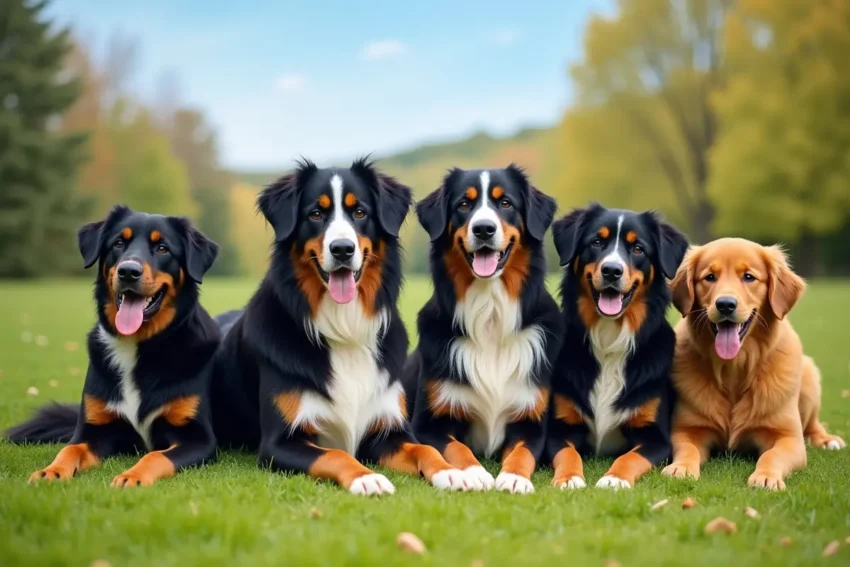Bernese Mountain Dogs vs. Similar Breeds: Making the Right Choice

The Bernese Mountain Dog has become one of the most recognizable breeds in America, with their tri-colored coats and gentle giant personalities winning over countless families. But here’s the reality – they’re not the right fit for everyone. Whether it’s their size, grooming needs, or unfortunately short lifespan, plenty of prospective owners find themselves looking at alternatives that might better suit their situation.
The good news? Several breeds share key characteristics with Berners while offering different advantages. Some are smaller, some live longer, and others need less maintenance. Understanding these options helps anyone make a smarter choice rather than falling in love with a look and then struggling with the reality of ownership.
Contents
- 1 Understanding the Bernese Mountain Dog Standard
- 2 Greater Swiss Mountain Dog: The Larger Cousin
- 3 Saint Bernard: The Gentle Giant Alternative
- 4 Exploring Smaller Alternatives
- 5 Newfoundland: The Water-Loving Giant
- 6 Rough Collie: A More Manageable Option
- 7 Golden Retriever and Leonberger Mixes
- 8 Making the Final Decision
Understanding the Bernese Mountain Dog Standard
Before comparing other breeds, it helps to know what makes a Berner a Berner. These dogs typically weigh between 70-115 pounds, with males considerably larger than females. They’re bred as working dogs from the Swiss Alps, which means they have specific traits hardwired into their DNA.
Their double coat requires consistent grooming – and they shed. A lot. Anyone who thinks they can get away with occasional brushing will find their furniture covered in fur within weeks. The coat also means they struggle in hot weather, which rules them out for people in warmer climates unless they’re willing to keep their homes cool year-round.
Then there’s the lifespan issue. Most Berners live 7-10 years, which is heartbreakingly short compared to many breeds. Cancer rates are high, hip dysplasia is common, and other genetic health problems crop up regularly. That’s not to say they aren’t worth it – plenty of owners say the years they get are absolutely worth the eventual heartbreak – but it’s something to weigh seriously.
Greater Swiss Mountain Dog: The Larger Cousin
The Greater Swiss Mountain Dog looks remarkably similar to a Bernese but with a shorter coat. They’re actually larger, often weighing 85-140 pounds, but that coat difference is significant. Less grooming, less shedding, and better heat tolerance make them more practical for some families.
Swissies have similar temperaments – loyal, calm, and good with kids. They were also bred as working dogs in Switzerland, so they share that steady, reliable personality. The downside? They’re even harder to find than Berners, and they come with similar health concerns, including a lifespan that’s still shorter than many would prefer.
Saint Bernard: The Gentle Giant Alternative
Saint Bernards share that same Swiss mountain heritage and calm demeanor. They’re even bigger than Berners, typically 120-180 pounds, but some families specifically want that extra-large presence. Their grooming needs depend on whether someone gets a short-haired or long-haired variety.
The temperament is arguably even more laid-back than a Berner. These dogs are famously patient with children and generally content to lounge around the house. They drool quite a bit though, which is a dealbreaker for some people. Health-wise, they face similar challenges to Berners, with shorter lifespans and joint issues being common concerns.
Exploring Smaller Alternatives
Not everyone has the space or physical ability to handle a 100-pound dog. For those who love the Berner look and personality but need something more manageable, a Mini Bernese Mountain Dog might seem appealing – though it’s worth researching what that actually means in terms of breeding practices and health. Some smaller options exist through careful selection or crossbreeding programs.
The Entlebucher Mountain Dog is the smallest of the Swiss mountain dog family, weighing just 40-65 pounds. They have the same tri-color pattern and herding background but in a much more compact package. These dogs are energetic and need plenty of exercise, making them better suited for active families rather than those wanting a calm companion.
Another option is the Australian Shepherd, which shares the herding background and intelligence without the massive size. They typically weigh 40-65 pounds and come in various colors, including tri-color patterns similar to Berners. The catch? They need significantly more exercise and mental stimulation. This isn’t a breed for someone wanting a dog that’s content with a couple of walks a day.
Newfoundland: The Water-Loving Giant
Newfoundlands often appeal to the same people drawn to Berners. They’re massive dogs, weighing 100-150 pounds, with sweet dispositions and a love for their families. The big difference is their relationship with water – Newfies are natural swimmers with webbed feet and water-resistant coats.
Their grooming needs are substantial, possibly even more demanding than a Berner. But many owners say their temperament is slightly gentler and more patient, especially with children. Health concerns exist here too, including heart problems and hip dysplasia, though some lines have longer lifespans than typical Berners.
Rough Collie: A More Manageable Option
Rough Collies bring that similar fluffy, long-haired appeal in a more moderate size. They typically weigh 50-75 pounds and have that gentle, family-oriented personality many people love about Berners. Their grooming needs are still significant, but they’re generally healthier with longer lifespans averaging 12-14 years.
The temperament differs somewhat – Collies tend to be more vocal and may have stronger herding instincts. They’re also more sensitive and responsive to training, which can be either a pro or con depending on what someone wants in a dog. They do better in various climates than Berners, though that thick coat still means summer heat requires caution.
Golden Retriever and Leonberger Mixes
Some people specifically look for mixed breeds that capture Berner characteristics while potentially improving health outcomes. Golden Mountain Dogs (Golden Retriever/Berner crosses) have become popular for this reason. They often get the friendly, trainable nature of both breeds with slightly better longevity.
Leonbergers offer another alternative that’s less commonly known. These German dogs were actually bred using Saint Bernards and Newfoundlands, among others, and they share that gentle giant personality. They’re massive – often 120-170 pounds – but many owners report they’re slightly more energetic than Berners while still being calm indoors.
Making the Final Decision
Choosing a dog breed shouldn’t be just about looks. The tri-color pattern and fluffy coat are beautiful, but they don’t mean much if the dog doesn’t fit into daily life. Climate matters, space matters, and honestly, the willingness to potentially face heartbreak sooner rather than later matters too.
Anyone considering these breeds should spend time with them in person. Visit breeders, go to dog shows, or connect with breed-specific rescues. What seems manageable in theory might feel overwhelming in reality – or vice versa. That 85-pound dog might be perfectly fine, or the grooming commitment might be more than anticipated.
The health aspect deserves serious thought too. Veterinary care for large breeds gets expensive, especially when dealing with genetic conditions. Pet insurance makes sense for any of these breeds, but it’s still an ongoing financial commitment on top of regular care costs.
What matters most is finding a dog whose needs match what can realistically be provided. The right breed isn’t necessarily the most beautiful one or the most popular one – it’s the one that will thrive in a specific home with specific people. That might be a Bernese Mountain Dog, or it might be one of these alternatives that offers something slightly different but equally rewarding.



